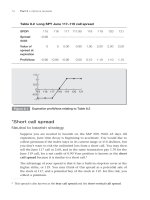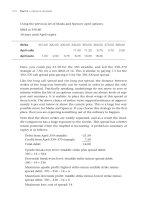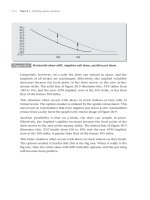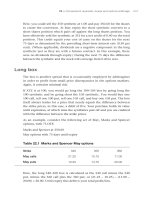CWNA guide to wireless LANs 2nd ch12
Bạn đang xem bản rút gọn của tài liệu. Xem và tải ngay bản đầy đủ của tài liệu tại đây (562.17 KB, 43 trang )
CWNA Guide to Wireless
LANs, Second Edition
Chapter Twelve
Personal, Metropolitan, and Wide Area
Wireless Networks
Objectives
• Define a wireless personal area network
• List the technologies of a wireless metropolitan
area network
• Describe the features of a wireless wide area
network
• Discuss the future of wireless networking
CWNA Guide to Wireless LANs, Second Edit
2
Wireless Personal Area Networks
• Wireless networks classified into four broad
categories:
– Wireless personal area network (WPAN): Handheld and portable devices; slow to moderate
transmission speeds
– Wireless local area network (WLAN): i.e., IEEE
802.11a/b/g
– Wireless metropolitan area network (WMAN):
Range up to 50 kilometers
– Wireless wide area network (WWAN): Connects
networks in different geographical areas
CWNA Guide to Wireless LANs, Second Edit
3
Wireless Personal Area Networks
(continued)
Figure 12-1: Wireless network distances
CWNA Guide to Wireless LANs, Second Edit
4
Wireless Personal Area Networks
(continued)
Figure 12-2: Point-to-point transmission
CWNA Guide to Wireless LANs, Second Edit
5
Wireless Personal Area Networks
(continued)
Figure 12-3: Point-to-multipoint transmission
CWNA Guide to Wireless LANs, Second Edit
6
Wireless Personal Area Networks
(continued)
• WPANs encompass technology designed for
portable devices
– PDAs, cell phones, tablet or laptop computers
– Low transmission speeds
• Three main categories:
– IEEE 802.15 standards
– Radio frequency ID (RFID)
– IrDA
CWNA Guide to Wireless LANs, Second Edit
7
WPANs: IEEE 802.15.1 (Bluetooth)
• Bluetooth uses short-range RF transmissions
– Users can connect wirelessly to wide range of
computing and telecommunications devices
– Rapid and ad hoc connections between devices
• 802.15.1 adapted and expanded from Bluetooth
– Designed for area of about 10 meters
– Rate of transmission below 1 Mbps
• Two types of 802.15.1 network topologies
– Piconet
– Scatternet
CWNA Guide to Wireless LANs, Second Edit
8
WPANs: IEEE 802.15.1 (continued)
• Piconet: When two 802.15.1 devices come within
range, automatically connect
– Master: Controls wireless traffic
– Slave: Takes commands from master
– Piconet has one master and at least one slave
• Active slave: Connected to piconet and sending
transmissions
• Parked slave: Connected but not actively
participating
CWNA Guide to Wireless LANs, Second Edit
9
WPANs: IEEE 802.15.1 (continued)
Figure 12-4: Piconet
CWNA Guide to Wireless LANs, Second Edit
10
WPANs: IEEE 802.15.1 (continued)
Figure 12-5: Slave device detected by a master device
CWNA Guide to Wireless LANs, Second Edit
11
WPANs: IEEE 802.15.1 (continued)
• Devices in piconet can be in one of five modes:
– Standby: Waiting to join a piconet
– Inquire: Device looking for devices to connect to
– Page: Master device asking to connect to specific
slave
– Connected: Active slave or master
– Park/Hold: Part of piconet but in low-power state
• Scatternet: Group of piconets in which
connections exist between different piconets
• 802.15.1 uses FHSS
CWNA Guide to Wireless LANs, Second Edit
12
WPANs: IEEE 802.15.1 (continued)
Figure 12-6: Scatternet
CWNA Guide to Wireless LANs, Second Edit
13
WPANs: IEEE 802.15.1 (continued)
Table 12-1: Comparison of 802.15.1 speed
CWNA Guide to Wireless LANs, Second Edit
14
WPANs: IEEE 802.15.3
• Created in response to limitations of 802.15.1
– High-rate WPANs
• Two main applications:
– Video and audio distribution for home entertainment
systems
• High-speed digital video transfer
• High-density MPEG2 transfer between video
players/gateways and multiple HD displays
• Home theater
• PC to LCD projector
• Interactive video gaming
– High speed data transfer
CWNA Guide to Wireless LANs, Second Edit
15
WPANs: IEEE 802.15.3 (continued)
• Differences between 802.15.3 and 802.15.1
–
–
–
–
–
Quality of Service (QoS)
Security
High data rates
Spectrum utilization
Coexistence
Table 12-2: IEEE 802.15.3 security modes
CWNA Guide to Wireless LANs, Second Edit
16
WPANs: IEEE 802.15.3 (continued)
• 802.15.3a: Will support data transfers up to 110
Mbps between max of 245 devices at 10 meters
– Ultrawideband (UWB)
– Intended to compete with USB 2.0 and FireWire
• IEEE 802.15.3b task group working on improving
implementation and interoperability of 802.15.3
• IEEE 802.15.3c task group developing alternative
physical layer standard that could increase speeds
up to 2 Gbps
CWNA Guide to Wireless LANs, Second Edit
17
WPANs: IEEE 802.15.4
• Sometimes preferable to have low-speed, lowpower wireless devices
– Size can be dramatically reduced
• IEEE 802.15.4 standard addresses requirements
for RF transmissions requiring low power
consumption and cost
Table 12-3: IEEE 802.15.4 data rates and frequencies
CWNA Guide to Wireless LANs, Second Edit
18
WPANs: IEEE 802.15.4 (continued)
• ZigBee Alliance: Industry consortium that promotes
802.15.4 standard
Figure 12-7: ZigBee and IEEE 802.15.4
CWNA Guide to Wireless LANs, Second Edit
19
WPANs: Radio Frequency ID (RFID)
Figure 12-8: RFID tag
CWNA Guide to Wireless LANs, Second Edit
20
WPANs: Radio Frequency ID
(continued)
• Passive RFID tags: No power supply
– Can be very small
– Limited amount of information transmitted
• Active RFID tags: Must have power source
– Longer ranges/larger memories than passive tags
Table 12-4: RFID tags
CWNA Guide to Wireless LANs, Second Edit
21
WPANs: IrDA
• Infrared Data Association
• IrDA specifications include standards for physical
devices and network protocols they use to
communicate
• Devices communicate using infrared light-emitting
diodes
– Recessed into device
– Many design considerations affect IrDA performance
CWNA Guide to Wireless LANs, Second Edit
22
WPANs: IrDA (continued)
Figure 12-9: IrDA diodes in device
CWNA Guide to Wireless LANs, Second Edit
23
WPANs: IrDA (continued)
• IrDA drawbacks:
– Designed to work like standard serial port on a
personal computer, which is seldom used today
– Cannot send and receive simultaneously
– Strong ambient light can negatively impact
transmissions
– Angle and distance limitation between
communicating devices
CWNA Guide to Wireless LANs, Second Edit
24
Wireless Metropolitan Area Networks
• Cover an area of up to 50 kilometers (31 miles)
• Used for two primary reasons:
– Alternative to an organization’s wired backhaul
connection
• i.e., T1, T3, T4 lines
– Fiber Optics
• Very expensive to install backhaul connections
• Often less expensive to use a WMAN to link remote
sites
CWNA Guide to Wireless LANs, Second Edit
25









